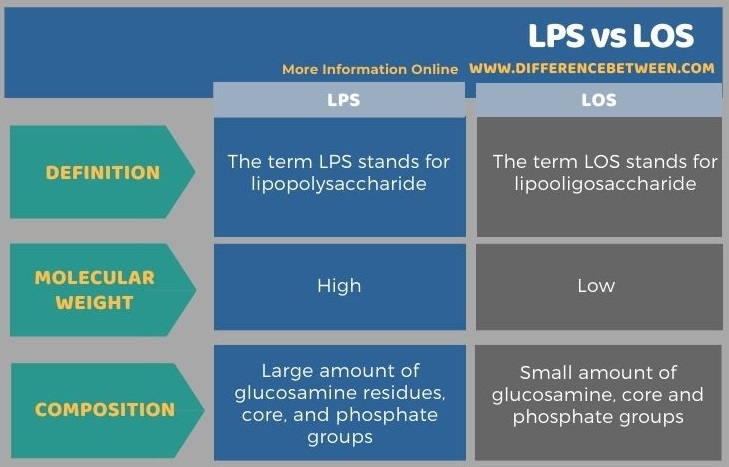Difference Between LPS and LOS
The key difference between LPS and LOS is that LPS has a very high molecular weight, whereas LOS has a low molecular weight.
Both LPS and LOS are bacterial lipopolysaccharides. The term LPS stands for lipopolysaccharide while the term LOS stands for lipooligosaccharide. We can find these organic molecules in the outer membrane of gram-negative bacteria. These molecules are large molecules having a lipid component and a polysaccharide component, an outer core and an inner core that are joined together with a covalent bond.
CONTENTS
1. Overview and Key Difference
2. What is LPS
3. What is LOS
4. Side by Side Comparison – LPS vs LOS in Tabular Form
5. Summary
What is LPS?
LPS stands for lipopolysaccharides. They are also named as lipoglycans and endotoxins. These are very large molecules having a high molecular weight. An LPS molecule contains a lipid component and a polysaccharide component containing O-antigen, an outer core and an inner core. These outer core and inner core are bound to each other via covalent chemical bonding. We can find these molecules in the outer membrane of gram-negative bacteria.

We can find LPS as the major component in the outer membrane of bacteria, and it can protect the membrane from certain chemical attacks. Moreover, LPS can increase the negative charge of the cell membrane of bacteria, and it helps the stabilization of the overall membrane structure. If the structure of LPS is mutated or if LPS is removed from the cell membrane of bacteria, it can cause the bacteria to die. However, we can recognize LPS as non-essential in some gram-negative bacteria. LPS can induce strong responses from normal animal immune systems.

What is LOS?
The term LOS stands for lipooligosaccharide. These are glycolipids we can find in the outer membrane of some types of gram-negative bacteria. E.g. Neisseria spp. It is low molecular weight bacterial LPS. This substance plays an important role in maintaining the integrity and functionality of the outer membrane of the gram-negative cell envelope. Moreover, these molecules can play an important role in the pathogenesis of certain bacterial infections because they can act as immunostimulators and immunomodulators. In addition, these molecules are responsible for the ability of some bacteria to display molecular mimicry and antigenic diversity. This aids in the evasion of host immune defenses and therefore contributes to the virulence of these bacterial types.
What is the Difference Between LPS and LOS?
LPS and LOS are biological molecules that can be found mainly in the outer membrane of gram-negative bacteria. The term LPS stands for lipopolysaccharide while the term LOS stands for lipooligosaccharide. The key difference between LPS and LOS is that LPS has a very high molecular weight, whereas LOS has a low molecular weight.
Moreover, LPS contains a large amount of glucosamine residues, core, and phosphate groups, while LOS contains a small amount of glucosamine, core and phosphate groups.
Below is a summary of the difference between LPS and LOS in tabular form.

Summary – LPS vs LOS
LPS and LOS are biological molecules that can be found mainly in the outer membrane of gram-negative bacteria. The term LPS stands for lipopolysaccharide. The term LOS stands for lipooligosaccharide. In summary, the key difference between LPS and LOS is that LPS has a very high molecular weight, whereas LOS has a low molecular weight.
Reference:
1. “Lipopolysaccharide.” Wikipedia, Wikimedia Foundation, 21 July 2020, Available here.
Image Courtesy:
1. “LPS” By Mike Jones – Own work (CC BY-SA 3.0) via Commons Wikimedia
2. “Kdo2-lipidA” By en:User:Lmaps and User:TimVickers – Modified version of en:Image:Kdo2 lipidA.png (CC BY-SA 3.0) via Commons Wikimedia
ncG1vNJzZmivp6x7pbXFn5yrnZ6YsqOx07CcnqZemLyue8OinZ%2Bdopq7pLGMm5ytr5Wau264z6xkmqaUYrmwv44%3D